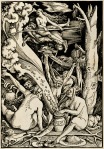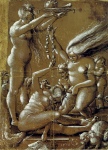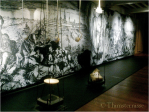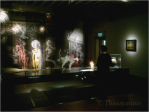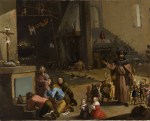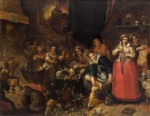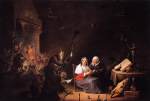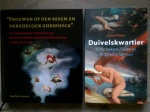It’s the witching season, and Museum Catharijneconvent in Utrecht has dedicated a temporary exhibition to just this theme. Catharijneconvent focuses on the preservation of Dutch christian art and history, so witchcraft may seem a strange subject. But it’s really not, if you realize that a lot of information about witchcraft in the Middle Ages and Renaissance (and thereafter) has been handed down to us by christian sources, for better or worse.
The exhibition, which is based on a 2011 research by guest curator Renilde Vervoort, focuses on two works by Pieter Bruegel that depict the christan apocryphal story of Saint James the Greater visiting the sorcerer Hermogenes. In her research, Vervoort argues that Bruegel’s depictions of witches in these works are the source of our typical witch with cauldron and black cat who flies through a chimney on a broom.
- Pieter Bruegel the Elder. The Story of Saint James the Greater and the sorcerer Hermognes. 1565.
At first, when I hadn’t seen the exhibition and hadn’t read Vervoort’s book yet, I was a bit sceptical about this idea. After all, there are lots of witches depicted with brooms, cauldrons, etc. before Bruegel’s time. However, Vervoort’s argument is about the specific combination of the aforementioned attributes, and the influence Bruegel had on later depictions of witchcraft, mainly in the Netherlands. In that context, her conclusion stands a lot stronger.
Now on to the the exhibition itself, which is a joy to visit. The Catharijneconvent is a lovely museum which is seated in an old monastry in the center of Utrecht. It is well known for its exhibitions that mostly focus on christian history, but are also very open to a non-christian audience. The exhibition of Bruegel’s Witches is a good example of that. For someone like me, who is interested in art history, folklore, and the history of witchcraft, this is like a child walking into a candy store.
- Hans Baldung Grien. Witches’ Sabbath. 1510.
- Urs Graf, after Hans Baldung Grien. Group of Witches. 1514.
The first room tells about the context in which witchcraft in 16th century Holland existed. We come across heretic sects and see paintings of the extremely cold weather that large parts of Europe experienced. Both are generally considered to be big influences on the second large outbreak of the witch craze in the late 16th century. Early drawings and engravings of witches by Hans Baldung Grien and others are on view (see above for a few examples). They are considered to have had a great infuence on how we see witches today. Vervoort however thinks the chance that Bruegel was directly influenced by them is fairly small. Doesn’t matter, I was so glad to finally see these fantastic works in real life! A large part of the room is taken by a modernversion of scales on which suspects of witchcraft were weighed. One can actually sit on these scales and listen to the questions that inquisitors would fire in your direction. In the back of this same room, we are confronted with the two prints of Bruegel around which the whole exhibtion is built.
- Sit on the scales and listen to the inquisitor’s bizarre questions to find out whether you are a witch..
- Exhibition room depicting aspects and attributes from Bruegel’s ‘James the Greater visiting Hermogenes’.
The next room kind of dissects the image of the which that is depicted on Bruegel’s first print, where the witches fly through the chimney. And after that, we get to see the impact that Bruegel’s work supposedly had on later artists, in a hallway filled with image after image about the now well known witch’s sabbath and witch’s kitchen. It’s a delight to see all these works together, by popular 17th century artists such as Cornelis Saftleven, Frans Francken II and David Teniers II. The repetition of the images really drives home the point that by now the concept of the witch on her broom flying through the chimney on her way to the sabbath was a well known subject. There seems to have been a small market for this kind of images. The exhibition refers to them as akin to our modern horror movies, something to take a creepy delight in.
- Cornelis Saftleven. James the Greater and Hermogenes. C. 1607.
- Frans Francken II. Witches’ Kitchen. C. 1610.
- David Teniers II. The Young Witch’s Initiation. 1640-50.
There was a more serious tone in these artworks too, as the discussion about the realness and dangers of witchcraft was still very lively in this period, and people were still sentenced to death over accusations of witchcraft. However, the Netherlands were a relatively calm corner of Europe when it comes to the witch craze. Of the tens of thousands of people that have lost their life to this black episode in European history, only ca. 200 were in what is now the area of the Netherlands. Also, some of the most enlightened thinkers on witchcraft came from this same area, such as Johannes Wier and Balthasar Bekker. Is it a coincidence that by far most of the witch images we know from the 16th and 17th centuries are from the Netherlands?
I’ll leave that question for now – let’s go back to the exhibition. There’s two more rooms, and I find both to be a bit disappointing after what we’ve seen so far. One room is about women as witches. The subject is very interesting, but it just doesn’t really fit the narrative of the rest of the exhibition, and when it comes to subject matter the artworks and objects gathered in this room are (in my humble opinion) all over the place. The last room is about the depiction of witches in our modern times. It’s an empty room with projections on the walls of witches in popular media, such as movies and animations. I knew modern witches would be depicted in this exhibition, but I expected a bit more of it – maybe some actual artworks, some objects or movie props, and maybe a nod to modern witchcraft?
- Renilde Vervoort’s ‘Heksen op den besem’ and Johan Otten’s ‘Duivelskwartier’
That said, I really enjoyed this exhibition! It was a feast to see all these witch images together. I definitely learned a thing or two from the exhibition, and from Renilde Vervoort’s study Vrouwen op den besem en derghelijck ghespoock (Women on brooms and similar hauntings), which I’m reading right now. I bought it in te museum shop, together with Johan Otten’s Duivelskwartier, which I wrote about last month.
It’s good to see that witchcraft, magic and folklore are getting more popular as research subjects. It teaches us a lot about the nature of people and about the ways of certain parts of the world. And to this pagan, it is also a source of inspiration.

